#gmz pavlovsk
Photo
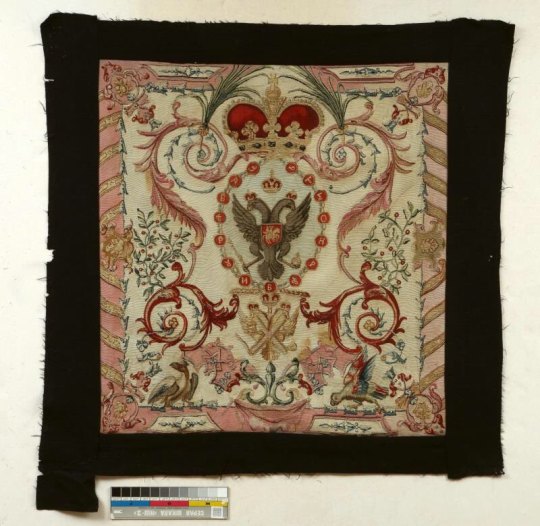

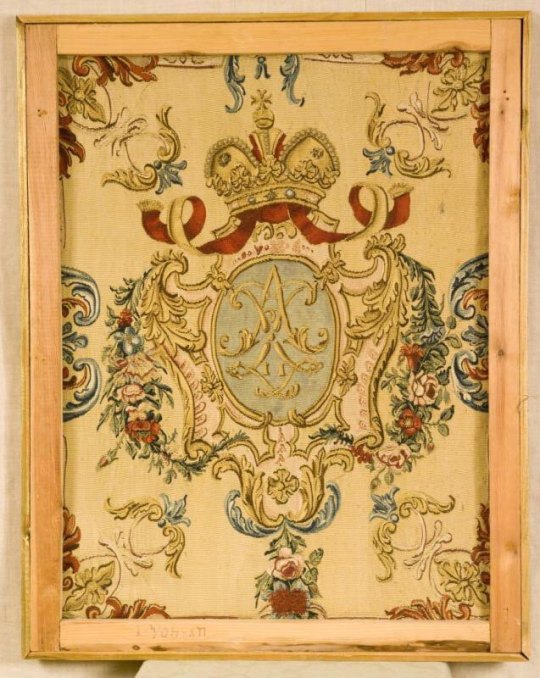



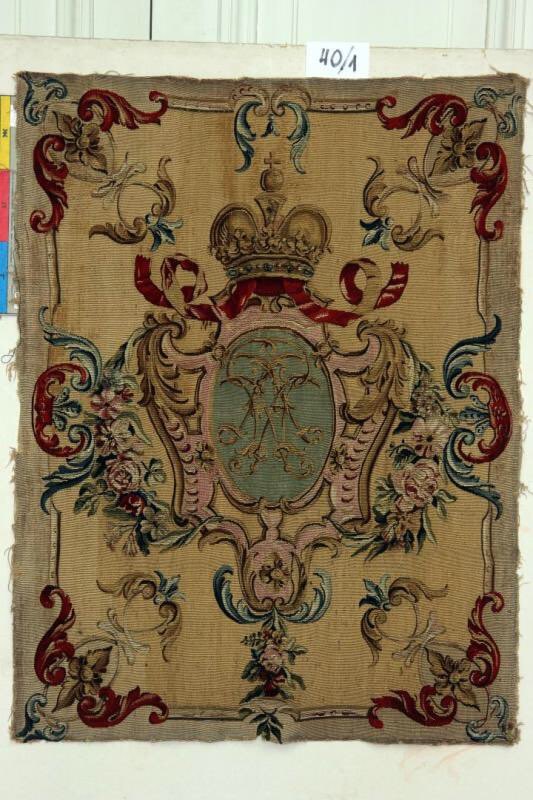
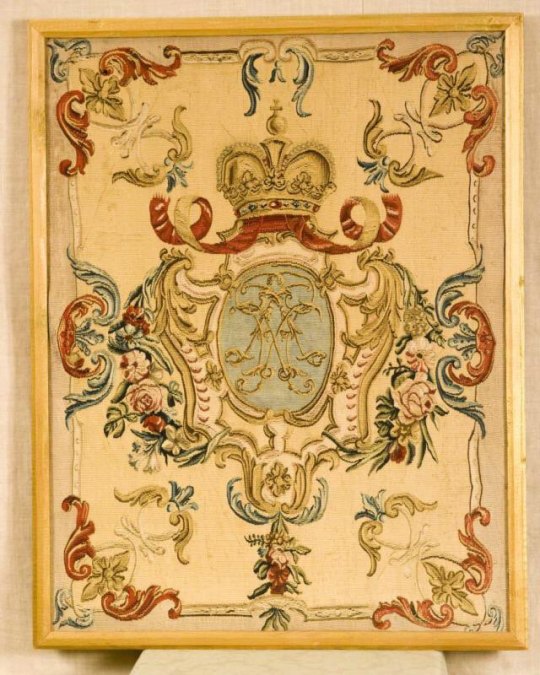
Folding-screen panels which survived from the Corner Reception-Room of Her Majesty at the Alexander Palace in Tsarskoe Selo
Here you have all of the tapestry panels from the folding/privacy screens which were used to decorate the Corner Reception-Room of Her Majesty. Originally, this room was decorated with three folding-screens, each of them were gilded, and were most likely executed by either the firms of N. Svirsky or F.F. Meltser & Co. (R.F. Meltser was the Court Decorator to Their Majesties). These tapestries which were fitted to various folding-screens (paravents) can be identified in the autochrome plate made during the late Summer of 1917 by war-time photographer Andrei Zeest. One tapestry panel depicts the double-headed eagle surrounded by scrollwork, filigree and ribbons. The other tapestry panels are said to be from the reign of King Louis XV of France by way of the monogram which is depicted in the center of each of the panels. All of the tapestry panels reside at GMZ Pavlovsk.
Please enjoy! Also, if you re-share and/or post these photographs elsewhere PLEASE credit Gosfond and GMZ Pavlovsk accordingly! Thank-you!
________________________________________________________________
Source:
Gosfond (State Museum Catalogue of the Museum Fund of Russia)
Link of courtesy:
www.goskatalog.ru
#alexander palace#gmz tsarskoe selo#gmz pavlovsk#tsarskoe selo#romanov#imperial russia#neoclassical#russian empire style#russian archival material#gosfond#empress alexandra feodorovna#louis xv#svirsky#meltser#furniture#folding screen#paravent
110 notes
·
View notes
Photo

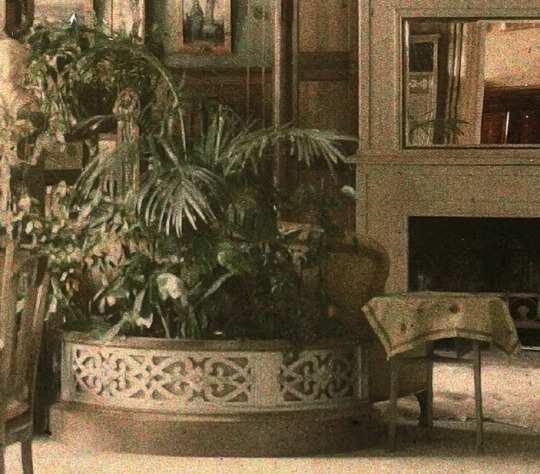
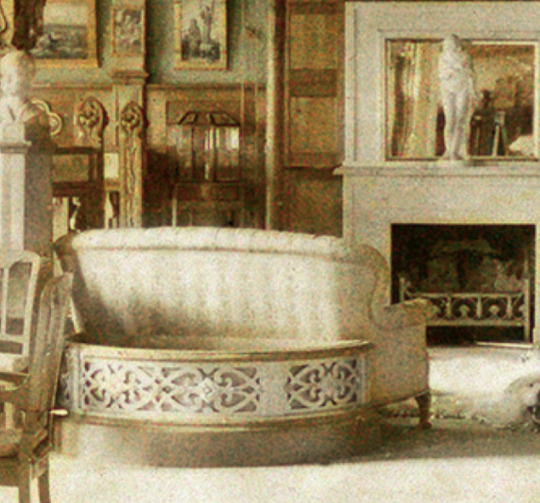

A surviving metal, open-work grille of gilt bronze rosettes and palmettes from one of the jardinières of the Maple Living-Room of Her Majesty at the Alexander Palace in Tsarskoe Selo
In the museum publication, “Report of the Tsarskoe Selo State Museum-Reserve for 2021,” there is a wealth of information on the going-on’s which have been happening at GMZ Tsarskoe Selo. Included in this publication are the restoration of objects from the apartments of Their Majesties, including this surviving jardinière grille.
I’ve translated the text as it originally is in Russian. I use Yandex for my translations as I have been told this is much better than other Internet translators:
Grid (detail of the jardiniere)
Russia, St. Petersburg. The end of the XIX century .
Metal; casting, stamping, gilding, painting
26.5 × 160.0 × 76.0 cm
Inv. No. ED-2386-IV
Restorers: N. V. Mazur, A.V. Novoselov
Head of work — restoration engineer
A. E. Novikov (LLC "Tsarskoye Selo Amber
Workshop")
Curator E. G. Stadler
________________________________________________________________
“During the restoration work, all kinds of dirt were removed, the deformation of parts was eliminated, the lost fasteners were replenished.
To solve the problem of restoration of the lattice surface and overhead parts (significant scuffs and scratches of the paint layer) a number of studies have been conducted to establish the original appearance of the object. It was revealed that the relief pads in the form of rosettes and palmettes are made of gilded brass, but subsequently painted over with silver paint in the color of the lattice surface. The Restoration Council of the museum decided to return the original gilded look to the linings, to preserve the damaged paint layer of the smooth surface and to paint the lattice in the color most appropriate to the historical appearance.
The openwork metal lattice is part of one of the two floor jardinieres that were part of the decoration of the Maple Living Room of Empress Alexandra Feodorovna. Indoor plants were placed in tubs in them, creating green zones of fresh flowers. Their wooden base was made of gray maple, as well as all the built-in furniture with a carved mezzanine and stairs. During the war, a significant part of the interior decoration was damaged; the preserved metal part of one of the jardinieres will again take its historical place after the restoration of the wooden base.”
________________________________________________________________
Please enjoy these images, and If you’d like to share them elsewhere, you can download them yourself and if you do so, PLEASE remember to credit the institution/news source/author/photographer - in this case Gosfond, GMZ Tsarskoe Selo, GMZ Pavlovsk, Andrei Zeest and the Tsarskoe Selo Amber Workshop, appropriately! Thank-you.
Photographs:
1. A surviving metal, openwork grille with gilt bronze rosettes and palmettes that decorated one of the jardinières. This piece was in the collection of GMZ Pavlovsk, now back at GMZ Tsarskoe Selo (digitised via Gosfond).
2. Cropped detail of one of Andrei Zeest’s autochrome negatives. Circa. September 1917. Property of GMZ Tsarskoe Selo.
3. Cropped detail of one of Andrei Zeest’s autochrome negatives. Circa. September 1917. Property of GMZ Tsarskoe Selo.
4. The surviving grille which has been restored by A.E. Novikov, N.V. Mazur, and A.V. Novoselov of the Tsarskoe Selo Amber Workshop.
Sources:
Gosfond (State Museum Catalogue of the Museum Fund of Russia)
GMZ Tsarskoe Selo (Tsarskoe Selo State Museum Reserve)
GMZ Pavlovsk (Pavlovsk State Museum Reserve)
Andrei A. Zeest - Wartime Photographer
"State Museum-Reserve "Tsarskoe Selo." Collection Catalog. Volume No. XVII. Book No. I." - V.F. Plaude. Circa. 2013.
“Report of the Tsarskoe Selo State Museum-Reserve for 2021.” - St. Petersburg. Circa. 2022.
Link of courtesy:
www.goskatalog.ru
https://tzar.ru/science/publications/report-2021
https://tzar.ru/science/publications/photo_catalogue
The two catalogues can be downloaded in PDF form via the links above. I believe you can access Gosfond (the first link) if you have a VPN, but don’t quote me on that. xD.
#alexander palace#tsarskoe selo#gmz tsarskoe selo#gmz pavlovsk#romanov#imperial russia#empress alexandra feodorovna#maple living room#art nouveau#jardiniere#russian archival material#gosfond#tsarskoe selo amber workshop#andrei zeest#historical restoration
16 notes
·
View notes
Photo


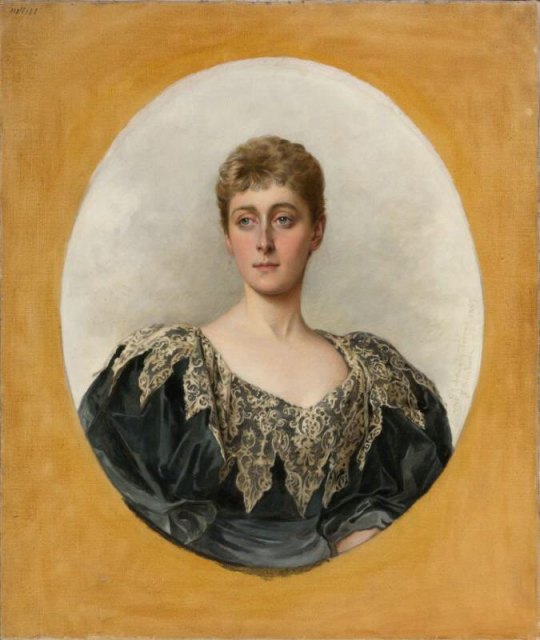

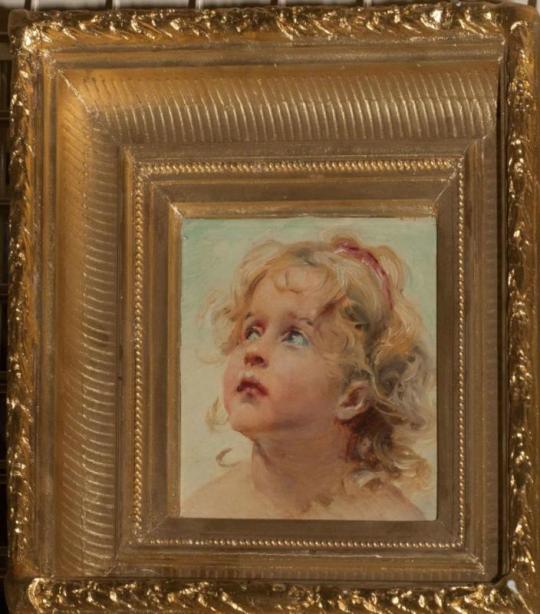
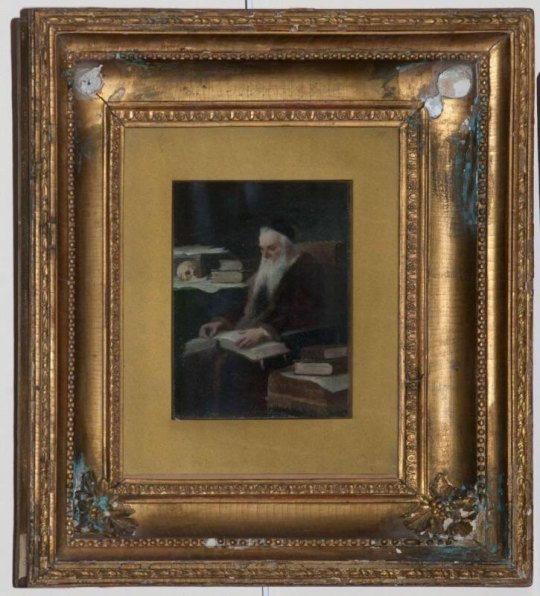



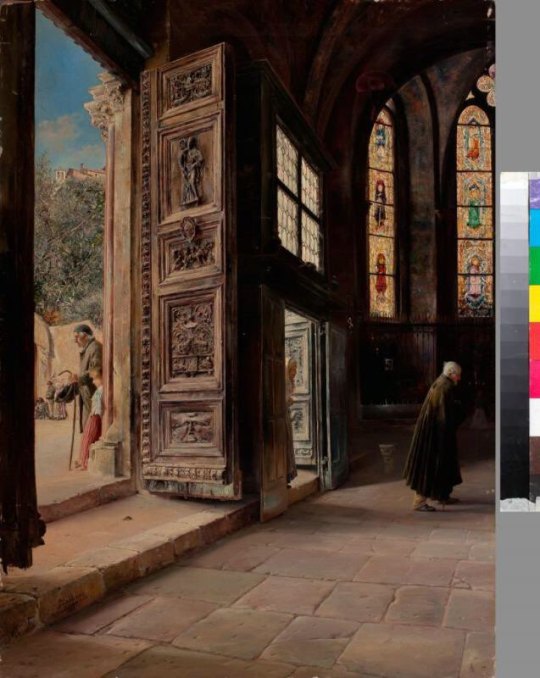
More of the paintings of the Palisandre Drawing-Room of Her Majesty at the Alexander Palace in Tsarskoe Selo
In the Palisandre Drawing-Room of the Empress, there was a multitude of paintings, watercolours, pastels and prints. Most of the paintings were hung along two particular walls - the wall leading to the Lilac Cabinet and the wall leading to the Maple Living-Room. The two most well-known of these paintings still reside with GMZ Tsarskoe Selo and have recently been reframed with recreated wooden frames to match the originals which were lost during the Second World War.
Gosfond (The State Museum Catalogue of the Museum Fund in Russia) has a wealth of a collection that spans the entire country with a range of objects ranging from drawings, photographs, sculpture, paintings, portraits, miniatures, vases, etc. GMZ Pavlovsk is the major keeper of what was evacuated from the Alexander Palace during the war. In its collection is 1,078 items which vary from paintings, fabric hangings from the rooms, sculpture, art glass, etc. Of these, I was able to find six paintings which up until 1941 hung on the walls of the Palisandre Drawing-Room of Her Majesty.
From the 1928 Catalog on the Alexander Palace-Museum (Furnishings) by I. Yakovlev and translated generously by Stephen R. de Angelis (available via www.bookemon.com), are the titles that correspond to these ten paintings:
"The Annunciation." Inscription: "Ave Maria Grazia Plena." Granitsch, S. Circa. 1895.
"Madonna and Child." Thumann, P. German School. Date Unknown.
"Portrait (waist-high) of the Princess Helena Victoria - cousin of Alexandra Feodorovna. Copy from Swoboda, J." Kobervein, Terell G. Circa. 1897.
"Portrait of Alexei Nikolaevich in his youth." Trifonov, I. Member of the Saint Petersburg Painting School and the Academy of the Arts from 1866. Circa. 1906.
"Child's Head." Makovskii, K.E. (1839-1915). Russian School. Date Unknown.
"Old Boyarin." Pelevin, I. Russian School. Date Unknown.
"Atrium at the last sunbeams." Bakalowicz, St. VI. (1857-1928). Russian School. Circa. 1896.
"Spanish Scene." Gallegos, J. Italian School. Circa. 1899.
"Monastery Hospital." Topham, Frank. W.W. Date Unknown.
"The Interior view of the Cathedral in Seville." Gallegos, J. Italian School. Circa. 1898.
________________________________________________________________
Please enjoy these images, and If you’d like to share them elsewhere, you can download them yourself and if you do so, PLEASE remember to credit the institution/news source/author/photographer - in this case Gosfond, GMZ Tsarskoe Selo, GMZ Pavlovsk, V.I. Yakovlev, and Stephen R. de Angelis, appropriately! Thank-you.
________________________________________________________________
Sources:
Gosfond (State Museum Catalogue of the Museum Fund of Russia)
GMZ Tsarskoe Selo (Tsarskoe Selo State Museum Reserve)
GMZ Pavlovsk (Pavlovsk State Museum Reserve)
”The Alexander Palace in Detskoe Selo,” - V.I. Yakovlev. Circa. 1927 (Republished in 1928), translated by Stephen R. de Angelis.
Link of courtesy:
www.goskatalog.ru
https://www.bookemon.com/book-profile/yakovlev-the-alexander-palace-1927/545267
Also, if anyone is interested, this is the original text which Mr. de Angelis translated from, which is free for download via this website:
http://elib.shpl.ru/ru/nodes/42498-yakovlev-v-i-aleksandrovskiy-dvorets-muzey-v-detskom-sele-ubranstvo-vmesto-kataloga-detskoe-selo-1928#mode/grid/page/27/zoom/1 (This is the republished catalogue, Circa. 1928)
#alexander palace#tsarskoe selo#gmz tsarskoe selo#gmz pavlovsk#romanov#imperial russia#empress alexandra feodorovna#palisandre drawing room#paintings#fine art#russian archival material#gosfond#obscure books
16 notes
·
View notes
Photo



Furniture which survived from the Corner Reception-Room of Her Majesty at the Alexander Palace in Tsarskoe Selo
Here are three chairs from the suite of furniture (made up of 18th Century and 19th Century pieces) of the Corner Reception-Room of Her Majesty. The large, oval-backed chair is one of two which were reupholstered but have been remarkably preserved and reside within the collection of GMZ Tsarskoe Selo. The other two, which are terribly beat-up and missing upholstery and even wooden parts such as arms, etc. reside within the collection of GMZ Pavlovsk which as many know has the most objects from the Alexander Palace of any of the museums which had objects sent to them after the Second World War.
The square-backed chair if one notices, still has remnants of the striped, liseré upholstery manufactured by the Sapozhnikov Factory in Moscow. This chair was one of a group, sporting sloped arms. These can be seen in almost every photograph of the Empress's Corner Reception-Room. The smaller, oval-backed chair was also one of a group which were scattered about the room, placed between windows and at the ends of console tables.I thought you would all find these photographs interesting. It really brings home the loss of the suburban palace-museums such as those like Tsarskoe Selo and Pavlovsk with photographs like these.
________________________________________________________________
Please enjoy these images, and as always no posts or the materials posted are publicly shareable outside of the group. However, if you'd like to share them elsewhere, you can download them yourself and if you do so, PLEASE remember to credit the institution/news source/author/photographer - in this case Gosfond, GMZ Tsarskoe Selo, and GMZ Pavlovsk appropriately! Thank-you.
________________________________________________________________
Source:
Gosfond (State Museum Catalogue of the Museum Fund of Russia)
Link of courtesy:
www.goskatalog.ru
#alexander palace#tsarskoe selo#gmz tsarskoe selo#gmz pavlovsk#romanov#imperial russia#empress alexandra feodorovna#gosfond#russian archival material#neoclassical#18th century#19th century#chairs#furniture
8 notes
·
View notes
Photo

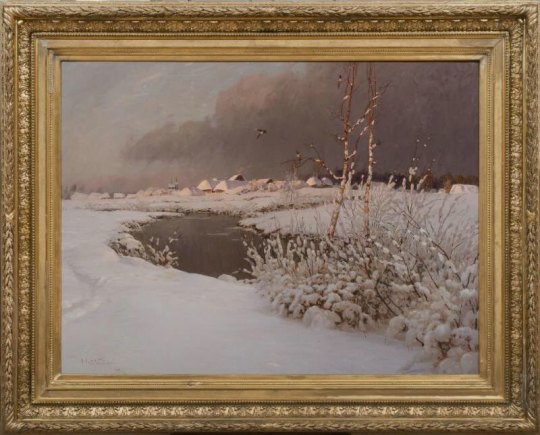

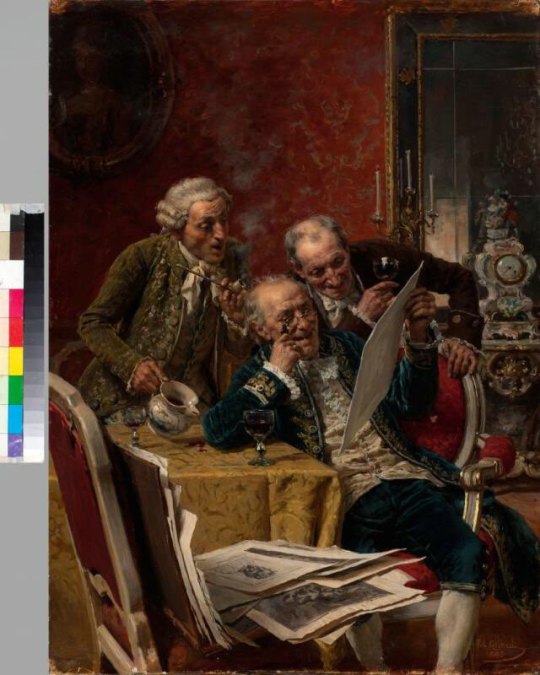
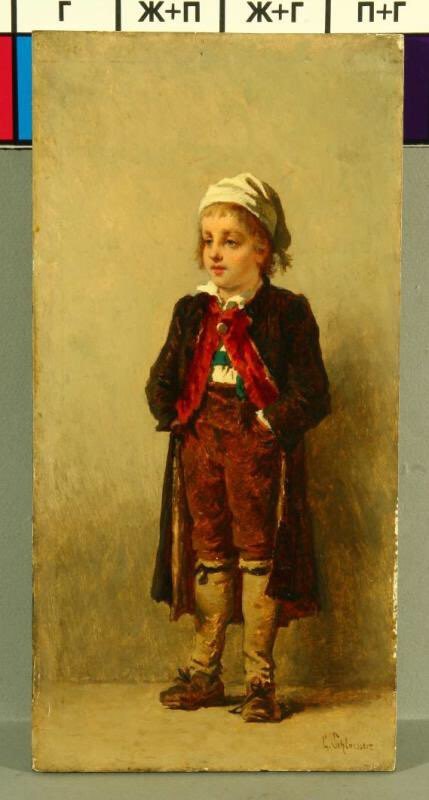

Some of the lesser known paintings of the Palisandre Drawing-Room of Her Majesty at the Alexander Palace in Tsarskoe Selo
In the Palisandre Drawing-Room of the Empress, there was a multitude of paintings, watercolours, pastels and prints. Most of the paintings were hung along two particular walls - the wall leading to the Lilac Cabinet and the wall leading to the Maple Living-Room. The two most well-known of these paintings still reside with GMZ Tsarskoe Selo and have recently been reframed with recreated wooden frames to match the originals which were lost during the Second World War.
Gosfond (The State Museum Catalogue of the Museum Fund in Russia) has a wealth of a collection that spans the entire country with a range of objects ranging from drawings, photographs, sculpture, paintings, portraits, miniatures, vases, etc. GMZ Pavlovsk is the major keeper of what was evacuated from the Alexander Palace during the war. In its collection is 1,078 items which vary from paintings, fabric hangings from the rooms, sculpture, art glass, etc. Of these, I was able to find six of the paintings which up until 1941 hung on the walls of the Palisandre Drawing-Room of Her Majesty.
From the 1928 Catalog on the Alexander Palace-Museum (Furnishings) by I. Yakovlev and translated generously by Stephen R. de Angelis (available via www.bookemon.com), are the titles that correspond to these six paintings:
"Lake early in the morning with the shore in the fog." Circa. 1896. Volkov, Ef. (b. 1843). At-will student of the Academy of Arts from 1867.
"Winter Landscape. A village on a river during sundown." Circa. 1895. Dubovskoi, Nik. (b. 1859). Member of the Academy of Arts from 1877.
"Moscow. Neskuchnoe - Alley and Park." Circa. 1896. Krachovskii, I.E. (1854-1914). Russian School.
"Lovers of Art (three members of the Court - Gentilhommes) in dress of the era of Louis XV look at paintings." Gilardi, P.S. Date Unknown.
"Boy with hands in his pockets." Schloesser, G. Date Unknown.
"Young girl playing the flute and a heron dancing around her." Svedomskii, P.A. (1849-1904). Dusseldorf Academy of Arts. Circa. 1897.
________________________________________________________________
Please enjoy these images, and If you'd like to share them elsewhere, you can download them yourself and if you do so, PLEASE remember to credit the institution/news source/author/photographer - in this case Gosfond, GMZ Tsarskoe Selo, GMZ Pavlovsk and V.I. Yakovlev, and Stephen R. de Angelis, appropriately! Thank-you.
________________________________________________________________
Sources:
Gosfond (State Museum Catalogue of the Museum Fund of Russia)
GMZ Tsarskoe Selo (Tsarskoe Selo State Museum Reserve)
GMZ Pavlovsk (Pavlovsk State Museum Reserve)
”The Alexander Palace in Detskoe Selo,” - V.I. Yakovlev. Circa. 1927 (Republished in 1928), translated by Stephen R. de Angelis. (2015)
Link of courtesy:
www.goskatalog.ru
https://www.bookemon.com/book-profile/yakovlev-the-alexander-palace-1927/545267
Also, if anyone is interested, this is the original text which Mr. de Angelis translated from, which is free for download via this website:
http://elib.shpl.ru/ru/nodes/42498-yakovlev-v-i-aleksandrovskiy-dvorets-muzey-v-detskom-sele-ubranstvo-vmesto-kataloga-detskoe-selo-1928#mode/grid/page/27/zoom/1 (This is the republished catalogue, Circa. 1928)
#alexander palace#gmz tsarskoe selo#gmz pavlovsk#tsarskoe selo#romanov#imperial russia#empress alexandra feodorovna#palisandre drawing room#paintings#fine art#russian archival material#gosfond#obscure books
7 notes
·
View notes
Photo
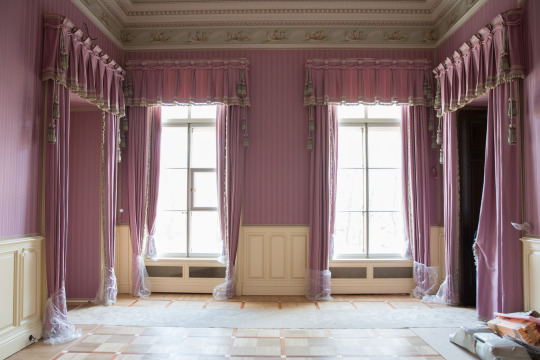
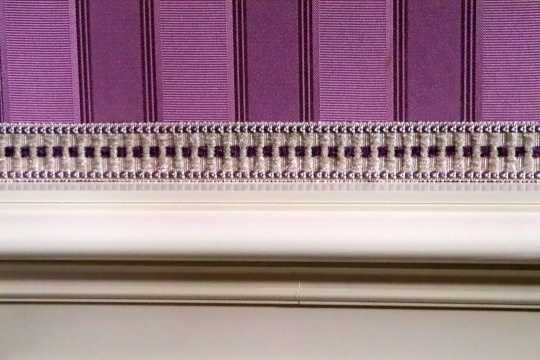
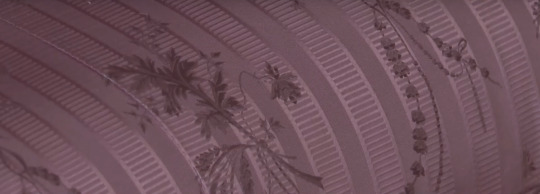


Currently, the architectural firm of Studio 44, Stavros, Artcorpus_Interiors, and others are hard at work on the finishing touches (furniture, and objects) of the first eight rooms to be unveiled in Summer of this year. A grand unveiling of the finished project of the rehabilitation/reconstruction of the Alexander Palace will be had no earlier than 2022.
One of the rooms to be showcased will be the Lilac Cabinet (Mauve Boudoir) of Her Majesty, Empress Alexandra Feodorovna. Stavros, the firm that has been responsible for all the reconstructed woodwork and paneling has brought this room back to life and in vibrant colour, of which many aren’t used to seeing. The silk on the walls and the upholstered furniture (of which other pieces are being recreated currently) were replicated by the master Janusz Matusiak (a Polish textile restorer) from surviving remnants of the original textiles used for the room when it was first constructed in the early years of the reign of Their Majesties.
GMZ Pavlovsk, via the State Catalog of the Museum Fund of Russia (Gosfond), has in its repositories a great deal of textiles (even whole bolts) from the Alexander Palace. Recognizable by its colour and the motif of stripes, as well as, the floral motif (raised with striped ground) are these remnants of the original textiles used for the room. The vertical-striped silk with broad bands was used for the walls and curtains. The lighter silk with a raised floral motif of garlands and flowers was used for the furniture. The staff at GMZ Tsarskoe Selo had the replicated textiles made according to these remnants.
Some have complained that the new silk is far too dark, or that it isn’t the right shade. These remarks and complaints are un-founded. Most of all the photographs of the Empress’s Cabinet were made in black and white. Re-printed on postcards during the museum period. Autochrome plates from 1917-1918 showing the room in two views show how it looked but are washed out. Yet, these autochromes, the museum era photographs, photographs from the private albums of the Imperial Family and the remnants of surviving fabric were used to recreate this lost space.
In Summer, this year it shall be seen nearly the same as it was. It may not be filled to the brim with everything it once had. It may not have the exact window placements, or may not even have the Louis XV style mural painted when it was first executed in the mid 1890′s. But it will be there. For all to see. That is what matters. Not little details to nit-pick over. Remember that.
Be grateful. Be understanding. Do not expect everything to be exactly the same. It won’t be, and that is okay. Truly.
Thank-you.
Photograph Credits:
GMZ Tsarskoe Selo (Tsarskoe Selo State Museum Preserve) - Photographs of the reconstructed Lilac Cabinet (Mauve Boudoir), and close-ups of the two silk textiles recreated for the room.
Gosfond (State Museum Catalog) - Remnants of silk textiles from the original room, which were used to make new silks for the reconstructed room (all currently residing at GMZ Pavlovsk).
#gmz tsarskoe selo#gmz pavlovsk#gosfond#mauve boudoir#lilac cabinet#empress alexandra feodorovna#studio 44#stavros#artcorpus_interiors#janusz matusiak#alexander palace#reconstruction#restoration#summer 2020#russia#romanov
12 notes
·
View notes
Photo
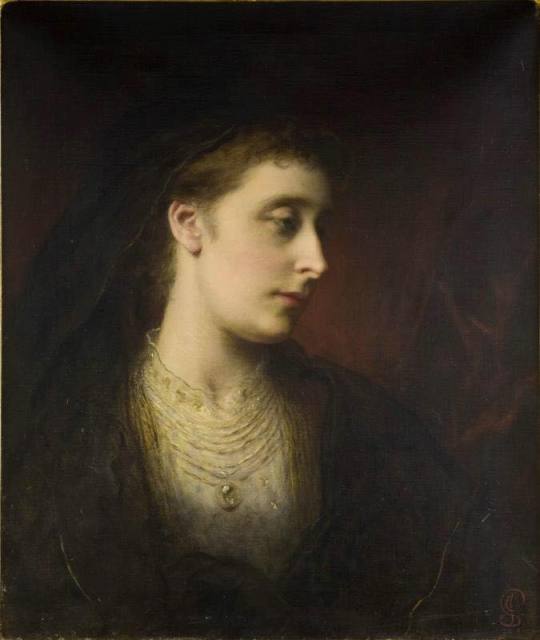
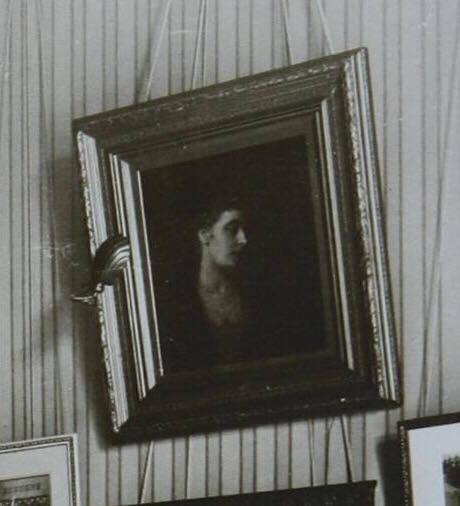
The State Catalog of the Museum Fund in Russia (Gosfond) is an amazing gem of finds. Last night while looking for some things, I found this portrait of the late Princess Alice of Great Britain, whom became the Grand Duchess of Hesse and by Rhine, as well as, wife of the Grand Duke Louis IV of Hesse. Princess Alice was the mother of the later Empress Alexandra Feodorovna (born Princess Alix of Hesse), and died of Diphtheria after giving her eldest son Ernest a kiss (a rule which she had never to have physical contact with the ill), who was also ill (the entire family were struck by it). Princess Alice died in December of 1878 uttering her last words “dear Papa.” She was buried on the 18th of December.
Her fourth daughter, Princess Alix (whom became the reigning Empress of Russia in 1894), later styled Alexandra Feodorovna had a portrait by the painter J. Sant of her beloved mother hung in her Lilac Cabinet at the Alexander Palace (Mauve Boudoir). Only ever seen in black and white photographs from the museum era, the portrait survived the Second World War and currently resides at Pavlovsk (the palace which has the largest collection of items from the Alexander Palace).
Please enjoy the post, and photographs!
Photograph credits:
Gosfond (State Museum Catalog) - Portrait of Princess Alice by J. Sant, Circa. 1878.
GMZ Tsarskoe Selo (Tsarskoe Selo State Museum Preserve) - (Cropped) detail from a photograph of the Lilac Cabinet of Her Majesty, Empress Alexandra Feodorovna of Russia.
#gosfond#gmz tsarskoe selo#gmz pavlovsk#mauve boudoir#lilac cabinet#empress alexandra feodorovna#darmstadt#princess alice of great britain#russia#Romanov#1878
18 notes
·
View notes
Photo
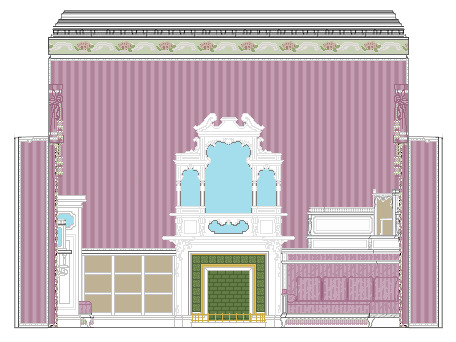
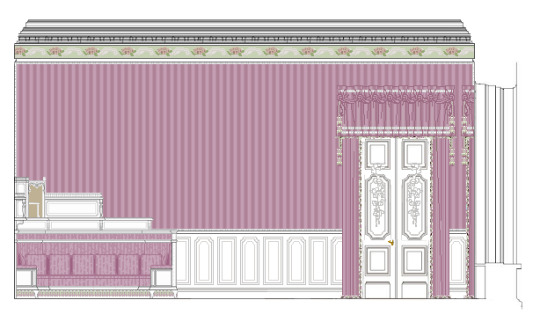
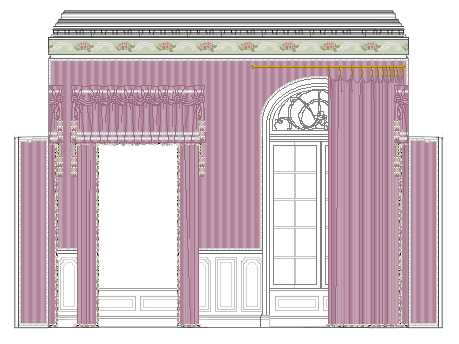

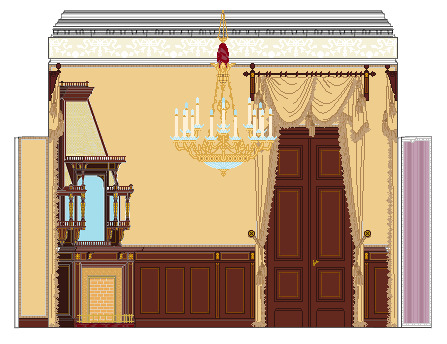
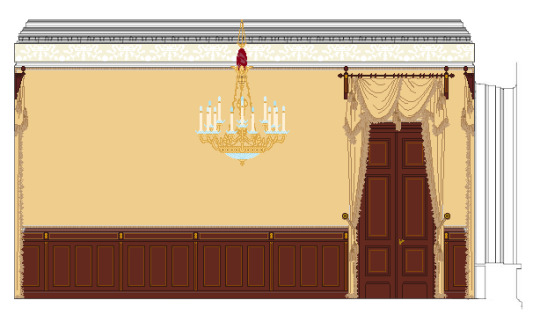
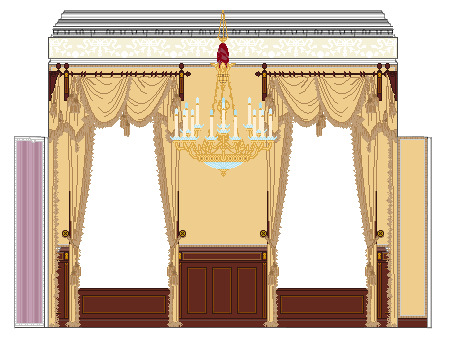

Renderings of the Lilac Cabinet (Mauve Boudoir), and the Palisandre (Rose-wood) Drawing-Room of Her Majesty, Empress Alexandra Feodorovna at the Alexander Palace as it looked before 1941. I started these renderings (with Windows/MS Paint) as the reconstruction project (rehabilitation as well) of the Alexander Palace in Tsarskoe Selo is going on currently.
PLEASE if you decide to re-post and/or share these, make sure that you credit me appropriately. I work very hard on my pieces, and these are no different. They took hours of research, fine-tuning colours, and even making colour palettes for each of the rooms. Thank-you!
On October 24th, a big unveiling was done of the currently-in-progress reconstruction. The rooms unveiled were the following:
1. The Bedchambre of Their Majesties.
2. The Lilac Cabinet (Mauve Boudoir) of Her Majesty.
3. The Palisandre (Rose-wood) Drawing-Room of Her Majesty.
4. The State Reception-Room of His Majesty.
5. The “Old” Working-Study of His Majesty.
6. The Moorish Bathchambre of His Majesty.
Rooms that are in the process of reconstruction (or restoration):
1. The Maple Drawing-Room of Her Majesty.
2. The “New” Study (Front Office) of His Majesty.
3. The Corner Reception-Room of Her Majesty.
4. The Mountain Hall (Parade Enfilade of State-Rooms).
5. The Imperial Library (total of four rooms, two being the Great and Small Libraries).
By Spring 2020, GMZ Tsarskoe Selo has said the first eight reconstructed interiors will be opened for the high season (most likely May) of tourism. The entirety of the rehabilitation project for the Alexander Palace will be completed no earlier than 2022. The Alexander Palace is to become a memorial museum to the Imperial Family.
Some background information on the Alexander Palace’s saga:
1792-1796: Designed and built for the future Tsar Alexander I, by the Italian architect Giacomo Quarenghi. It is designed essentially as a Summer estate, and not a full palace.
1894-1917: Permanent residence of Tsar Nicholas II, Empress Alexandra and their five children. The Imperial Family began to live at the Alexander Palace on a permanent basis more so in 1905.
1917-1918: (September) autochrome plates are made during the inventory of the Palace complex at Tsarskoe Selo.
1918-1941: The Alexander Palace is kept as a museum “honouring” the Imperial Family. Looting happens from with-in the Palace-museum. Between 1930 and 1941, the NKVD has permission to use the left wing (not the Imperial Wing, which was the right one) as a “holiday” establishment. An orphanage is established in the former rooms of the Imperial Children during this period. In 1941, evacuation of the Palace-museums in and around Saint Petersburg begins. Over 800 pieces of art-work and even furniture are evacuated from the Alexander Palace by the last curator at this time; Anatoly M. Kuchumov. 30,082 Total pieces were in the Alexander Palace in 1941, including 20,000 books from the Imperial Library (and personal collections of the Imperial Family).
1942-1944: The German forces (National Socialist Party, Nazi’s) occupy Tsarskoe Selo and make the Alexander Palace SS headquarters of operations. Along with Spanish allies, they loot and damage the Palace complex of Tsarskoe Selo. Much wooden decoration of the interiors is used as fire-wood. Shelling and artillery fire further damages the interiors.
1944-1946: Inventory of the suburban palace complexes. The Alexander Palace is the least-damage of them, and so all the collections are sent here. The Palace is mothballed, and in 1946, given to the USSR Academy of Sciences to store the collections of the Institute of Russian Literature.
1947-1951: The Alexander Palace begins a lengthy process for a major exhibition on the life of Alexander Pushkin (150th Anniversary, which Tsarskoe Selo has been renamed to). During this period, the remnants that remained of the damaged rooms of the Imperial Family were completely destroyed. Generic, Russian Empire style rooms were installed to preserve the work of Quarenghi. In 1951 the ownership of the Palace-museum is transferred to the Russian Navy. In the same year, what is left of the Alexander Palace’s collection (part of the collection of the evacuated items in the central repository of museum funds of the suburban palace-museums is received at Pavlovsk.
October 2009: Ownership of the Alexander Palace is given back to GMZ Tsarskoe Selo.
June 2009-2011: The Parade Enfilade, and roof of the Alexander Palace are restored and fixed for the 300th Anniversary of the founding of Tsarskoe Selo. These three State-Rooms original to Quarenghi’s design are unveiled in 2011 to the press and tourists after.
2015: Studio 44, headed by Nikita Yavein was awarded the commission for the project of the reconstruction and rehabilitation of the Alexander Palace. A press release is held in the Alexander Palace detailing the reconstruction, and rehabilitation project.
2015-2019: The Alexander Palace (closed in 2015) has been under a comprehensive reconstruction/rehabilitation project under the auspices of GMZ Tsarskoe Selo and Studio 44, the firm awarded the commission in 2015. Stavros, a furniture design firm in Saint Petersburg has presided over all the wooden decoration; Artcorpus_Interiors has presided over all of the ceramic tiling, and was predominantly responsible for the work on the Moorish Bathchambre of His Majesty. Janusz Matusiak was responsible for all of the reproduction textiles (curtains, furniture upholstery, etc) for the reconstructed interiors.
October 24th, 2019: A second press release is held in the Alexander Palace for the unveiling of the current progress of the reconstruction: Eight historical interiors (of which one was still extant from after the Second World War) were unveiled to the press. It is anticipated that the eight reconstructed rooms will be fully opened to the public during the high season of tourism in May most likely. The project itself will be finished no earlier than 2022.
#alexander palace#nicholas ii#empress alexandra feodorovna#giacomo quarenghi#gmz tsarskoe selo#studio 44#stavros_spb#artcorpus_interiors#janusz matusiak#Tsarskoe selo#Russia#reconstruction#rehabilitation#restoration#Александровский дворец#Царское село
12 notes
·
View notes